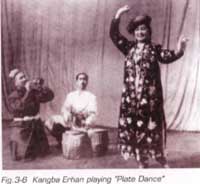EXCEPTS FROM CHINESE DANCE
by Sun Jingchen, Luo Xiongyan, Zi Huayun
Spreading the Sparks of the Dance Art in Modern China
Dance has spread across the whole of modern China. From the foot of the Tianshan Mountain to the coast of the South China Sea... Kangba Erhan (1922-1994) was reputed as "the first dancer of the Xinjiang Uygur Autonomous Region". Born in Kashi, where "one can sing if he can speak and can dance if he can walk", she demonstrated her dancing talents very early.
At the end of the 1930s, she entered the Moscow Music and Dance Institute and fortunately performed in the same play with G. Ulanova, the world-famous ballerina. At the beginning of the 1940s, she came back to China. Employing her professional knowledge, she brought various kinds of folk dances scattered throughout Xinjiang onto stage. Her shows in border areas and the hinterland had a big influence. She accompanied the "Xinjiang Youth Dance Troupe" to perform in Nanjing and Shanghai in 1947 and created a furore. Due to her lovely but dignified dance, Kangba Erhan was reputed as "Mei Lanfang of Xinjiang".
 Kangba Erhan was not only an artist, but also an educator She was dean of the Folk Art Department in the Northwest Art Institute for many years, when she systematically sorted out the teaching materials of different ethnic group dances in Xinjiang and fostered several generations of excellent dancers. Representative works of hers include "Plate Dance", "Linpadaite" and "Wuxiake". The "Plate Dance" was approved as one of the Dance Classics of the Chinese Nation in the 20th Century. (Fig.3-6)
Kangba Erhan was not only an artist, but also an educator She was dean of the Folk Art Department in the Northwest Art Institute for many years, when she systematically sorted out the teaching materials of different ethnic group dances in Xinjiang and fostered several generations of excellent dancers. Representative works of hers include "Plate Dance", "Linpadaite" and "Wuxiake". The "Plate Dance" was approved as one of the Dance Classics of the Chinese Nation in the 20th Century. (Fig.3-6)
Along the coast of the South China Sea, Liang Lun was the most influential artist. He was born in 1921 and once studied in the Guangdong Provincial Art School. At the critical moment, he plunged himself into the Anti-Japanese war. Using his specialty in art, he performed Successively in Kunming of Yunnan Province, and Hong Kong and Southeast Asia. He explored hard the development road of the modern Chinese dance.
 In 1946, Liang joined the "China Song and Dance Art Association" founded in Hong Kong the same year and became even more creative. His major works include "Questions and Answers on Lugou Bridge" and "Hungry People" finished in Kunming, "Moonlight Dance of Axi" and "Drum Dance of Sani people" of the ethnic groups and "Joys and Sorrows of the Chinese People", "Production Trilogy" and "Bridal Sedan Chair at the Gate". All of them were warmly welcomed by patriotic overseas Chinese. He also sorted out, wrote and performed many dances of Myanmar and Indonesia and popularized dance education abroad, so he enjoyed a great reputation. After the People's Republic of China was founded, Liang Lun became a leader of dances in south China. He contributed much to the creation, education and theory research of dance.
In 1946, Liang joined the "China Song and Dance Art Association" founded in Hong Kong the same year and became even more creative. His major works include "Questions and Answers on Lugou Bridge" and "Hungry People" finished in Kunming, "Moonlight Dance of Axi" and "Drum Dance of Sani people" of the ethnic groups and "Joys and Sorrows of the Chinese People", "Production Trilogy" and "Bridal Sedan Chair at the Gate". All of them were warmly welcomed by patriotic overseas Chinese. He also sorted out, wrote and performed many dances of Myanmar and Indonesia and popularized dance education abroad, so he enjoyed a great reputation. After the People's Republic of China was founded, Liang Lun became a leader of dances in south China. He contributed much to the creation, education and theory research of dance.
 In the long and hard revolutionary process, new forms of dance also spread to revolutionary bases. Since the beginning of the 1930s, revolutionary songs and dances had been found in the Soviet Area and the Red Army. Propaganda teams could be found climbing snow mountains and going through the marshland in the Long March. They were both soldiers and actors.
In the long and hard revolutionary process, new forms of dance also spread to revolutionary bases. Since the beginning of the 1930s, revolutionary songs and dances had been found in the Soviet Area and the Red Army. Propaganda teams could be found climbing snow mountains and going through the marshland in the Long March. They were both soldiers and actors.
